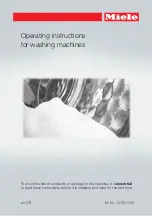
BNP
®
55 SUCTION BLAST CABINET
Page 13
© 2019 CLEMCO INDUSTRIES CORP.
www.clemcoindustries.com
Manual No. 23350, Rev G, 02/19
4.7
Shutdown
4.7.1
Shut off the air-supply valve, bleed the air-
supply line, and drain the compressed-air filter and dust-
collector pulse reservoir/manifold.
4.7.2
Switch OFF the lights and exhauster.
5.0
ADJUSTMENTS
5.1
Blasting Pressure (pilot regulator)
5.1.1
The pilot regulator (located on the top-left side of
the cabinet), enables the user to adjust blasting pressure
while blasting to suit the application. The suitable
pressure for most purposes is about 80 psi. Lower
pressures may be required on delicate substrates and will
reduce media breakdown. Higher pressure may be
required for difficult blasting jobs on durable substrates,
but will increase media breakdown. If pressure is too high,
suction in media hose will decrease, and if high enough
cause blowback in the hose. Optimal production can only
be achieved when pressure is carefully monitored.
5.1.2
To adjust pressure, unlock the knob by pulling it
out, as shown in Figure 14, and turn it clockwise to
increase pressure or counterclockwise to decrease
pressure. Pressure may drop slightly from closed-line
pressure when blasting starts. Once operating pressure
is set, push the knob in to lock it to maintain the setting.
Figure 14
5.2
Air Jet Adjustment ‒ Figure 15
5.2.1
Thread the air jet 4-1/2 to 5 full turns into the
gun body. Doing so will leave 3-1/2 to 4 threads
exposed past the lock nut. Tighten the lock nut to
maintain the setting. Refer to Section 9.3 for optional
adjusting tool, which correctly positions the jet.
Instructions are provided with the tool.
Figure 15
5.3
Media-Air Mixture (media flow) ‒ Figure 16
5.3.1
Check the media stream for correct media-air
mixture; media flow should be smooth and appear as a
light mist coming from the nozzle.
5.3.2
If media does not flow smoothly, loosen the
locking nut and adjust the metering screw until the upper
holes in the metering stem are closed off and the lower
holes are fully open, as shown in Figure 16. This
adjustment is a starting point.
5.3.3
If pulsation occurs in the media hose, either media
is damp and caked, or not enough air is entering the media
stream. While blasting, loosen the locking nut and slowly
turn the adjusting screw out (counterclockwise when
viewed from the top) until the media flows smoothly.
Tighten the locking nut finger-tight to maintain the setting.
Figure 16
5.3.4
If media flow is too light, decrease air in the
mixture by turning the metering screw in (clockwise when
viewed from the top), covering more of the holes so less air
enters the media hose. Tighten the locking nut finger-tight
to maintain the setting.
5.4
Reclaimer Static Pressure
5.4.1
Correct static pressure varies with size of
reclaimer and the size, weight, and type of media.
5.4.2
Adjust static pressure by opening (handle in-line
with air flow) or closing (handle perpendicular to air flow)
When viewed from the knob end,
turn clockwise to increase pressure;
turn counterclockwise to decrease pressure.
Lock Nut
Air Jet
3-1/2 to 4 threads between
lock nut and air
jet hex
Push knob in to lock it.
Pull knob out to unlock.
Adjustment Knob
Blast Pressure Regulator
Located on the upper-left side of cabinet.
Adjusting Screw
Locking Nut
Lower holes fully open.
Upper holes
fully closed.















































